If you’re looking to learn the differences between Real User Monitoring (RUM) and synthetic monitoring, keep reading. We’ve outlined 11 key differences, but maybe we should say 11 key ways the two complement each other.
1. Passive versus active website monitoring
A monitor is considered passive or active based on the event that triggers the monitor.
Real User Monitoring
A user activates Real User Monitoring by entering a URL or clicking on a link to a webpage that contains the RUM scripts. Those scripts (located in the head of the document) begin tracking the performance of the RUM enabled page as the user experiences it. Because the monitoring needs a user’s interaction with a webpage, this type of monitoring is considered passive monitoring. Notice in the RUM chart below, from about 7 pm. to 7 am. the page views drop off dramatically going from tests as frequent as 75 an hour to less than 20.
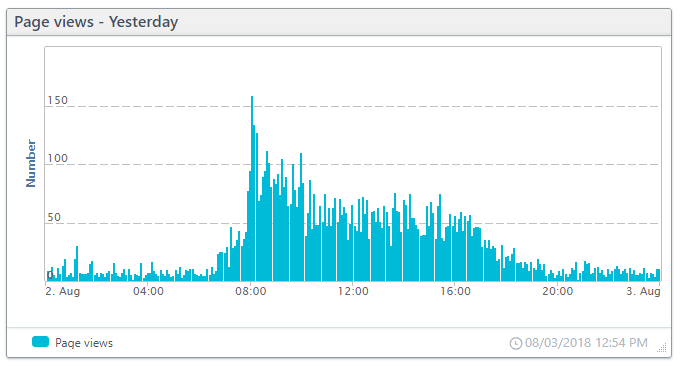
RUM page views over 24 hours.
Synthetic monitoring
For synthetic monitoring, a computer connects and possibly interacts with a webpage or web server on a regularly scheduled basis. The computer checks for availability, performance, or function (maybe all three). This computer is most likely part of a worldwide network of computers that test the site. You can see in the chart below the synthetic checks occur in a consistent manner around the clock. Because the monitoring is automatic without relying on users, synthetic monitoring is considered active monitoring.
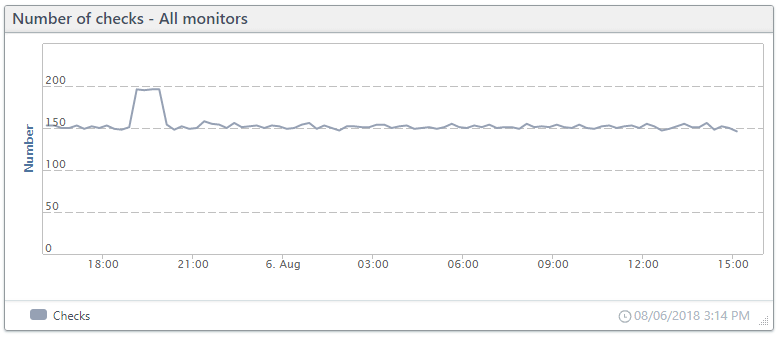
Check frequency for synthetic monitoring (Your settings and your plan determine frequency.).
2. Real User Monitoring vs. synthetic monitoring: Locations
When monitoring a website or service, you want your tests to originate as close to the actual users’ locations as possible. Keeping monitoring locations close helps identify localized issues such as latency and DNS errors.
Real User Monitoring
You can’t get any closer to your actual users than the users themselves. Real User Monitoring can capture latency issues that may not show up in synthetic monitoring because it captures the performance based on the users’ actual locations, devices, and connections.

RUM map showing location and concentration of users
Synthetic monitoring
You need a large worldwide network of checkpoint computers for synthetic monitoring so that you can pick test locations as close to your users as possible. Although Uptrends has one of the largest checkpoint networks available, it can’t offer the granularity of Real User Monitoring.
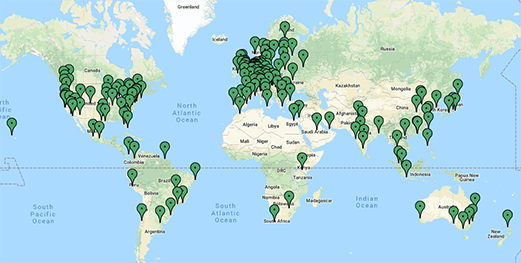
Map of Uptrends’ 184 synthetic testing sites
3. RUM vs. synthetic monitoring: Alerts
Alerting clues you in on performance, functional, and downtime issues with a website or service.
Real User Monitoring
As a passive monitoring type, RUM may not provide the alerting you typically get and expect from a synthetic monitor. If a user can’t access the site, RUM has no way of knowing that the user is having an issue.
Long lapses between RUM connections could signify an outage, but unless you’re Google or Amazon, long lapses may naturally happen and lead to false alerts. Although Uptrends does plan to add alerting to RUM in the future, most consider alerting based on RUM reactive because the problem has already affected the user’s experience.
Synthetic monitoring
The power of synthetic monitoring comes from alerting. You know how your website or service is supposed to behave, and with regularly scheduled tests on that behavior, you can capture downtime, malfunctions, and performance issues.
With synthetic monitoring, you get actionable, detailed notifications about issues immediately. Most consider synthetic monitoring proactive because you can discover and fix many issues before the users experience them.
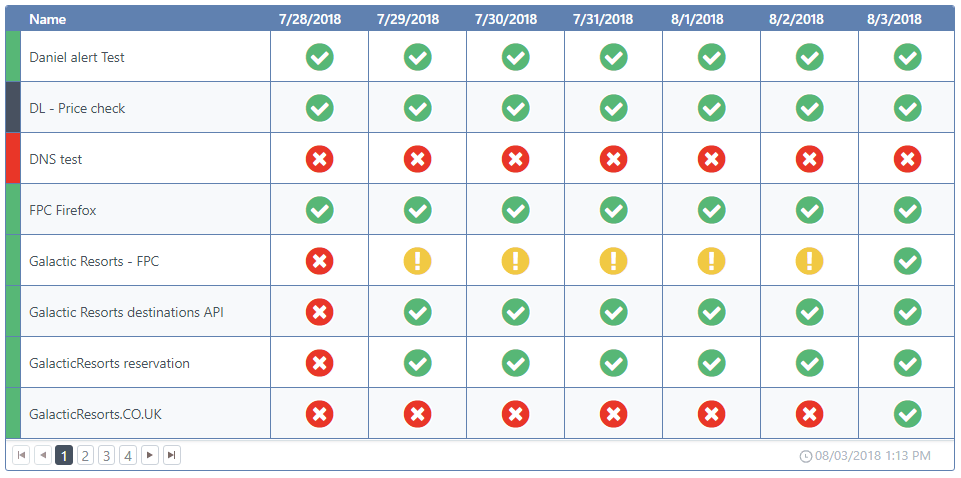
Synthetic monitoring public status page showing monitoring results.
4. Real User Monitoring vs. synthetic monitoring: Availability
Uptime is essential for protecting brand reputation and revenue. For example, Amazon’s Prime Day 2018 generated negative press and angry customers when they were not able to access Amazon’s sales and received pictures of dogs instead. To avoid angering users, synthetic monitoring is much better suited for uptime monitoring because you can monitor and respond to availability problems much faster.
Real User Monitoring
Real User Monitoring isn’t a reliable uptime monitoring tool. Because of its passive nature, localized outages, DNS poisoning, SSL certificate issues will most likely go unnoticed until users start to complain.
Synthetic monitoring
Synthetic monitoring evolved from availability monitoring, and it is the best suited for the task. The constant checks made from a worldwide network capture availability issues from a full outage to localized outages. Advanced availability monitors can check DNS and SSL records directly to verify that nobody has tampered with them. Other availability monitors can make sure your databases, email servers, SFTP servers, and any other public-facing server remains up and running.
Synthetic monitoring also gives you the ability to track and prove your SLAs (Service Level Agreements). Continuous, steady monitoring captures any downtime, and, based on your SLA settings, you can quickly see when you’re dangerously close to failing to meet your obligations.
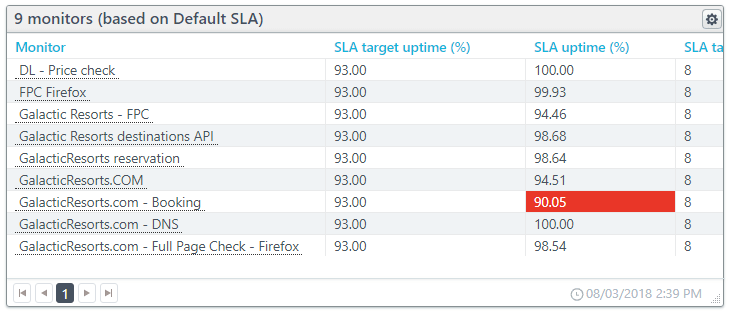
SLA Report for several monitors
5. Real User Monitoring vs. synthetic monitoring: Performance
Studies have shown that a website needs to load in under two seconds on the desktop and under three seconds on a mobile device to improve conversion rates and retain customers. Both RUM and Synthetic monitoring help you track your site performance.
Real User Monitoring
RUM gives you detailed performance information based on your users’ aggregated experience. As the data comes in, Uptrends combines the information with the other users’ experiences in real-time. RUM breaks down the data to see how users experience your website based on the page viewed, location, device, operating system, and browser.
You can get performance data based on:
- Load times including time to first byte and page ready time;
- Network times including redirect duration, DNS duration, connection duration;
- Backend times including send and receive duration;
- Frontend times including DOM and render duration;
- Download time.
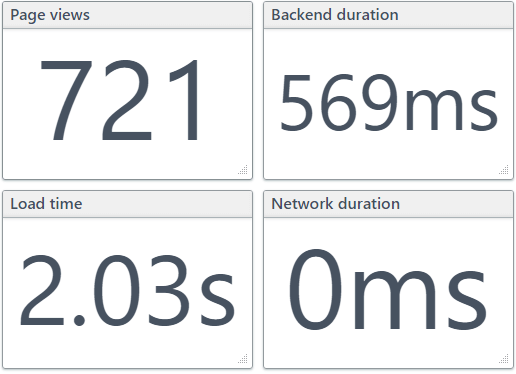
RUM single metric tiles
Synthetic monitoring
Synthetic performance monitoring such as Uptrends’ Full Page Check can give you detailed performance on an element-by-element basis. You can see how the type, size, and the number of elements affect load time. You get your page-load progression in a convenient waterfall chart that makes it easy to identify problem page elements and locate bottlenecks.
You get the following data on the individual elements (including third-party elements):
- Resolve,
- TCP Connect,
- HTTPS Handshake,
- Send,
- Wait,
- Receive, and
- Timeout.
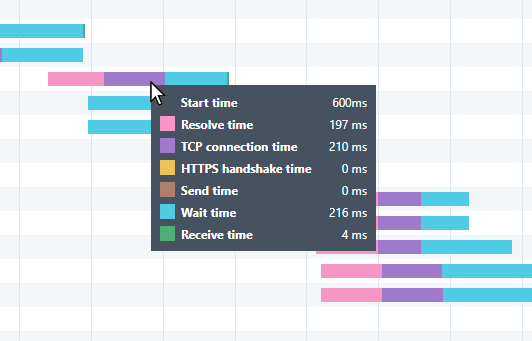
Synthetic Full Page Check waterfall with individual element metrics.
6. Real User Monitoring and synthetic monitoring: Real-browser monitoring
Knowing how your website performs based on real browsers is a must because, as you know, not all browsers perform equally.
Real User Monitoring
You might be surprised at the number of different browsers and browser versions your visitors use when accessing your site. With RUM, you get detailed performance data based on the visitor’s browser choice. Clicking on the magnifying glass (see figure below) allows you to drill down and see the versions your visitors used.
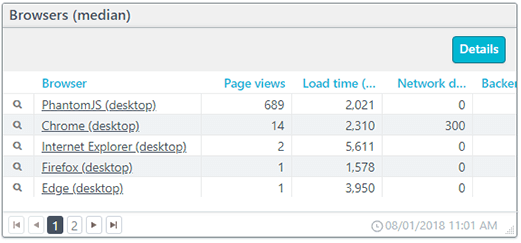
RUM performance data based on browser
Synthetic monitoring
Synthetic testing uses real browsers as well. For example, Uptrends uses real browsers for Web Application Monitors and performance monitoring. Performance monitoring allows you to choose between current versions of Chrome, Internet Explorer, Firefox, and Phantom JS for your testing.
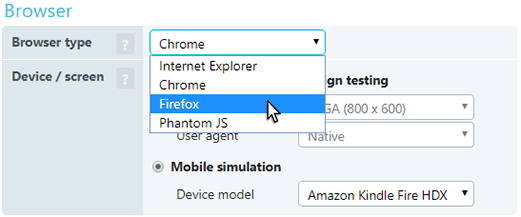
Options for real-browser monitoring in Uptrends synthetic monitoring
7. Real User Monitoring and synthetic monitoring: Mobile monitoring
Mobile has overtaken desktop use in virtually every market, and knowing how your site performs on different mobile devices is important to your users and your SEO now that Google considers mobile performance when ranking sites.
Real User Monitoring
Real User Monitoring gives you details about the mobile experience on the devices used by your site’s visitors when accessing your content. You can quickly see the types of devices your site visitors use the most and adjust your site to make sure all of your users get an amazing experience.
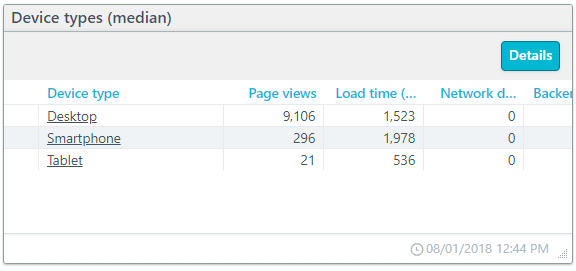
RUM report showing the device types used to access a RUM enabled site.
Synthetic monitoring
Synthetic monitoring can emulate any device by altering the user agent, adjusting the screen size, and throttling the bandwidth. You can’t make synthetic monitors to simulate all of your mobile user environments (well you could, but who wants to?), but by setting up your synthetic monitors to check on the most common device types, you can get a close simulation of the users’ experiences.
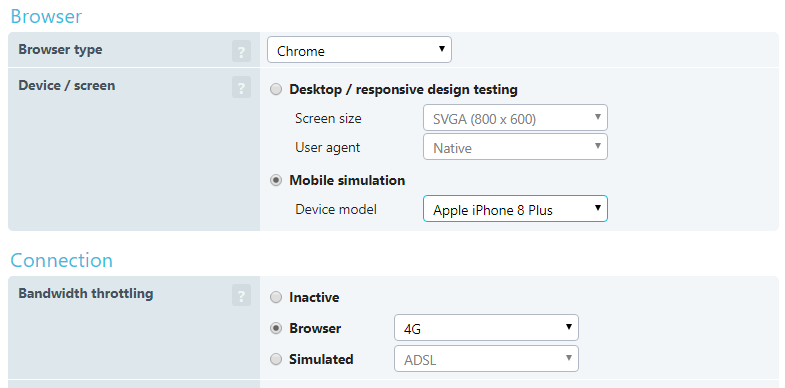
Synthetic options for simulated mobile testing.
8. Real User Monitoring vs. synthetic monitoring: Operating systems
Not all operating systems are created equal, and your users may use a large variety of devices and operating systems to access your content. You may have a few users out there still using Windows Vista, Mac OS 10.8, Android Kit-kat, or just about anything else.
Real User Monitoring
Again, measuring for the individual components of the users’ environments is the real power of Real User Monitoring. No matter what operating system your visitors use, RUM gathers detailed data about the users’ experiences while accessing your pages.
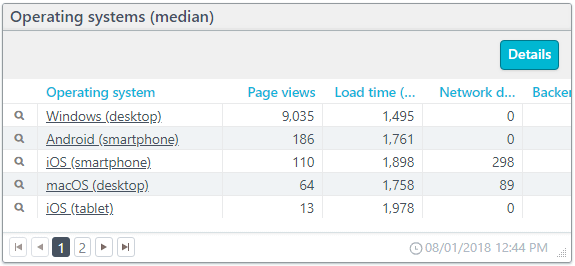
RUM table with user operating system information
Synthetic monitoring
Although synthetic monitoring can simulate varying connection speeds and browsers, your tests always run on the checkpoints operating system. In our case, we use systems running Microsoft Windows operating systems.
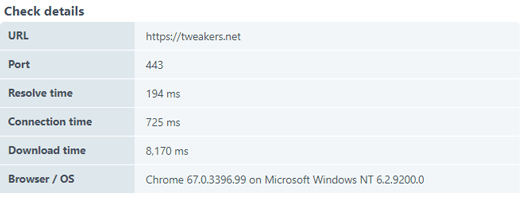
A check detail indicates that the operating system is Windows NT 6.2 or Windows 8.
9. Real User Monitoring vs. synthetic monitoring: Connection speeds
Connection speeds vary based on location and device type.
Real User Monitoring
Your RUM performance data is based on actual connection speeds experienced by your users. The connection speeds recorded come complete with network latency, and load times based on the processing power of the device used. No estimations needed.
Synthetic monitoring
Synthetic monitoring is subject to the Internet infrastructure of the surrounding area, but for the most part, these are fast machines with fast internet connections. Bandwidth throttling helps simulate slower connections along with estimated network latency.
10. Real User Monitoring vs. synthetic monitoring: Functionality
When your site relies on the ability of users to complete tasks like logging in, making a purchase, or interacting with forms, you need to know when those crucial transactions fail.
Real User Monitoring
Real User Monitoring can tell you that a page loaded and how fast it loaded for a user based on their individual environment, but it can’t tell you if the page’s worked as it should.
Synthetic monitoring
Synthetic monitoring (Web Application Monitoring) works like a bot, and it can perform all of the same actions a user normally would on a website. If anything unexpected happens, you’ll know about it.
11. Real User Monitoring vs. synthetic monitoring: Reporting
Monitoring is nothing without the reports, and both types of monitoring give detail-rich reporting.
Real User Monitoring
Your RUM reporting tells you about your users’ locations, what devices types they use, operating systems, and browsers they use and how your site performs for them based on their varying systems and locations. RUM arranges your data in interactive charts organized by user environment factors.
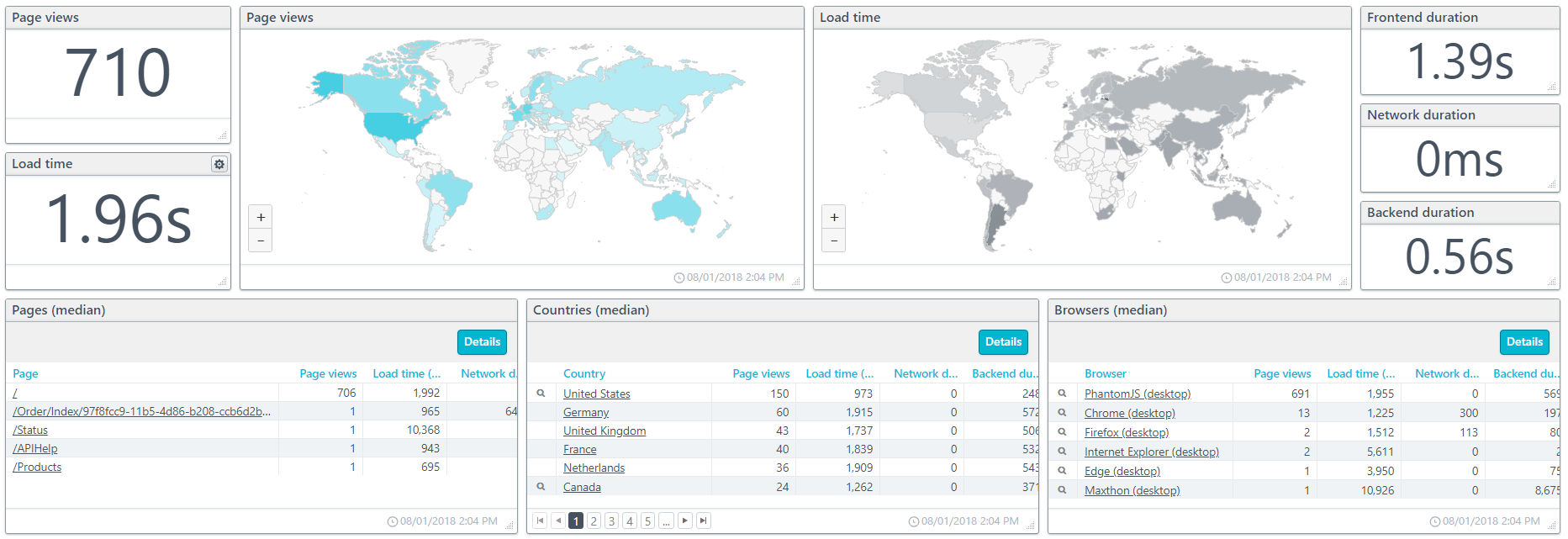
Portion of a RUM dashboard showing key metrics.
Synthetic monitoring
Synthetic monitoring gives you information on uptime, performance, and function that you can’t get from RUM reports. You can see how individual page elements behave, see bottlenecks, and spot trends with interactive charts and tables.
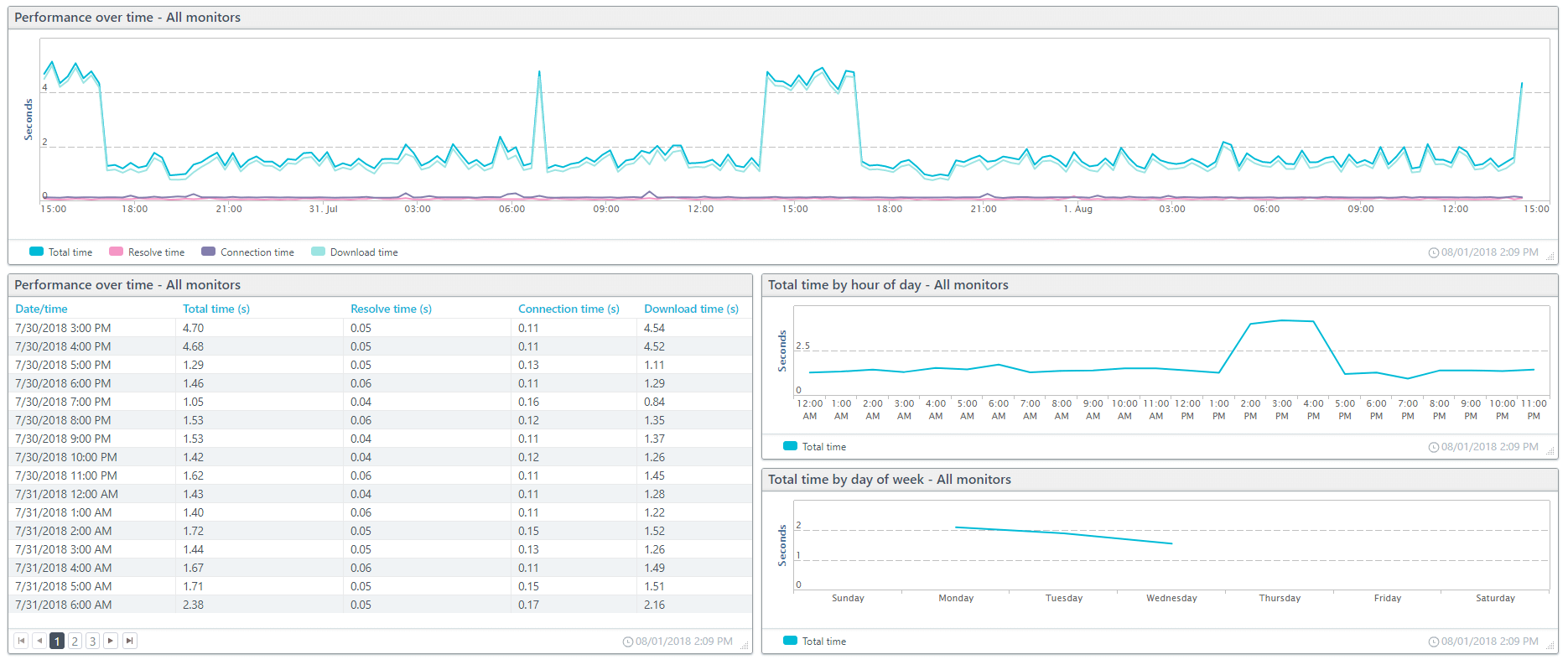
Synthetic monitoring performance dashboard
Final thoughts
We can continue to point out ways that the two monitoring approaches differ, but in reality, together, you gain a fully rounded view of your web presence when you use Real User Monitoring and synthetic monitoring together.
RUM tells you how your users currently experience your site, and the information from your Real User Monitoring reports guide your synthetic monitoring decisions. Once you’ve identified a problem in RUM, properly configured synthetic monitors can frequently take you directly to the root cause of the problem.
If issues appear in RUM that don’t show up in your synthetic monitoring, you may need to expand your checkpoints to capture latency that you’ve been missing, or you may need to modify your performance monitors to closer match your users’ environments.
Your synthetic monitors can watch over your digital presence beyond what RUM can capture. Synthetic monitoring can watch your email, database, SFTP, and any other server critical to yours and your customers’ success.
If you’re a current Uptrends subscriber and you haven’t tried RUM yet, go ahead and start your free 30-day trial. If you aren’t a current subscriber, you can sign up for a free no-commitment trial today and try both RUM and synthetic monitoring today!





Leave a Reply